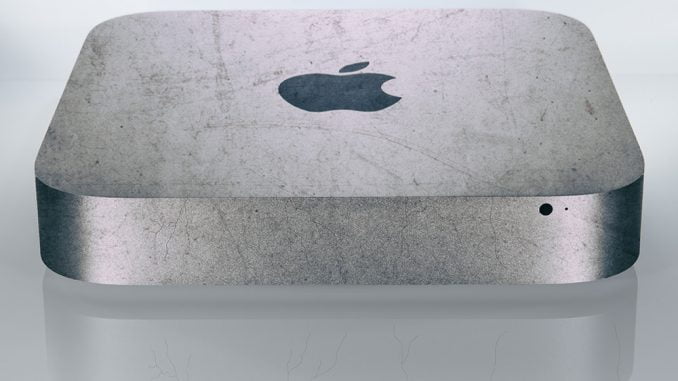

Multimedia professionals rely on solid tools to get the job done, and those tools have typically been Apple’s Mac lineup. But as Apple shifts its focus more to its MacBooks and iPhones, it’s neglected a tiny, but important product: the Mac mini.
Why am I singling out the lowly Mac mini? Because it’s currently the only desktop in the entire Apple lineup to play in the under $1,000 price point; an important psychological barrier for many computer shoppers.
It’s also an important barrier for enthusiast multimedia shooters who aren’t filling studios with $3,000 Mac Prosthat haven’t been updated significantly in years.
The Mac mini has been an easy-to-live-with photo and video editor for years. Even with its meager integrated graphics chips, with a few careful upgrades even a demanding shooter can edit batches of photos and full HD video with ease.
But the enthusiasts have moved forward. People are shooting 4K video on their DSLRs, and at $179 for a Samsung Gear 360, why not try out 4K, 360-video shooting?
Well, you won’t be trying it on a Mac mini, with its slow dual-core processor and integrated graphics.
Why the Mac mini Needs to Raise Its Game
The natural reaction would be to say “Get an iMac” but anything even close to $1,000 from Apple is woefully underpowered by today’s standards and has a small screen that isn’t a Retina display. The kicker is that the integrated graphics on that $1,049 model won’t get you to the land of smooth 4K and 360 video editing.
It’s amongst editors in these new mediums, the hobbyist/enthusiast/semi-pro adding new 360/VR tools to their toolbox, that Apple is losing the most mindshare. One of the most popular headsets out there, the Oculus Rift, still doesn’t support Mac because of middling graphics cards. If you walk into one of the premiere incubators of 360 video/VR work, Syracuse University’s Alan Gerry Center for Media Innovation, you’ll find all Alienware machines, except for the one lonely iMac that doesn’t run any headsets. New editors coming onto the scene are not starting out on Apples and will likely never get to experience them.
That’s bad for Apple in the long run. As someone who taught photojournalism at a school with an entirely Nikon-based consignment, I saw that graduating students carried their preferences learned in school with them to the professional world. More students of mine ended up with Nikons just because it’s what they knew.
Bang for the Buck
Someone buying into a system to edit 360-video can see that something like this $950 Asus will match a $2,300 iMac, at least on paper. When you spec out a loaded Mac mini, it costs more than a capable PC and it still can’t do the basics for this medium. Why would anyone pay these prices when the performance for multimedia editors isn’t there?
I’ve been a Mac user for a long time, and I wanted to believe that Apple had the 360 enthusiast willing to drop a grand covered, at least if they spent money on a new machine in 2017. So I gave it a shot, judiciously upgrading a Mac mini, adding a solid state hard drive into the mix along with 16 GB of memory. The Mac mini only offers older dual core i5 and i7 processors anyway so I didn’t make the upgrade there. Even at this modest level, I was already pushing $1,200. The Apple store employee who helped me configure the machine expressed cautious optimism that the machine would be up to scratch.
I loaded up my favorite video editing software, Final Cut Pro X, added the Dashwood 3D tools and got cracking, only to find that editing 360 footage from a Garmin Virb 360 (4K, not even the higher 5.7K the camera is capable of) was an exercise in frustration, with stuttering footage and dropped frames everywhere. Even simply playing back the footage in the GoPro VR Player resulted in the same issues.
I then pit the Mac mini against the above-mentioned, less expensive Asus model, which tore through the footage in Adobe Premiere Pro without breaking a sweat, likely thanks to its dedicated NVIDIA GeForce GTX 1060 graphics card. If Asus can cram all of hardware this into a box the size of a Playstation, I’m sure Apple could have worked something out for a Mac mini.
As an unexpected bonus, I discovered that Microsoft is in tune with 360-video. It’s natively supported in the Windows 10 movie player, and the Edge browser works with 360 as well. Safari can’t claim that and Apple doesn’t natively support 360-video in Sierra.
It’s clear that Apple is on shaky ground in its lower-priced machines when it comes to supporting the next generation of multimedia editors. While upper-echelon iMacs are capable machines, Apple ignores entry and mid-level users at their own peril.
It’s hard for me, the longtime Mac user to say this, but when it comes to the next generation of video — that is, 360, 4K, and VR work — it’s time for a PC. Game, set, match.
Are you a 360-video editor? Do you design VR environments? Sound off on the setup you use to edit this stuff in the comments.
